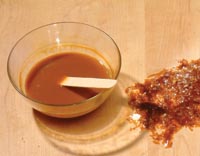
Each type of finish has its good and bad points, e.g. oils and thin oil-based finishes give better results as a base coat for popping the grain, while water-based finishes build up quickly and level well. Poly makes a good tough topcoat. I once read that you can use shellac on top of anything and it will bond. Question: Could you use shellac as a bonding coat between an oil-base coat, a water-base middle and a Poly top coat? Would there be any drawbacks?
Michael Dresdner: Actually, it is a simple question with a simple answer. Yes, you can use shellac between oil-base, water-base, and poly provided it is dewaxed shellac, like Zinsser’s new SealCoat? (a premixed dewaxed shellac). There are no drawbacks related to the shellac, but putting layers of finish with different color gradients (oils and shellac are amber, polyurethane is bluish gray, acrylic water-base is clear) and different refractive indices (the speed at which light goes through, and is therefore bent by, a clear material) can make it (the shellac?) less clear. Think of what a pencil in a glass of water looks like. It appears to change its direction and angle as it enters the water. Imagine that happening with each layer of finish. Now imagine the different color gradients added like sheets of tinted plastic wrap. Get the picture?
Ian Kirby: The fancy name for what goes on when one finish is put onto another is “interface adhesion.” In this scenario, you are messing with four interfaces. The variables are too many to contemplate, but if you think it’s a good idea, try it on some scrap wood.





